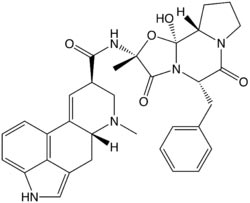|
HOME >>
Chemicals
>>
Chemicals List 1 >>
Ergotamine
Ergotamine
CAS number 113-15-5
Ergotamine is an ergopeptine and part of the
ergot family of alkaloids; it is structurally and biochemically
closely related to ergoline.
It possesses structural similarity to several neurotransmitters, and
has biological activity as a vasoconstrictor.
It is used medicinally for treatment of acute migraine attacks
(sometimes in combination with caffeine), and to induce childbirth
and prevent post-partum haemorrhage.

Systematic (IUPAC) name
(6aR,9R)-N-((2R,5S,10aS,10bS)- 5-benzyl-10b-hydroxy-2-methyl-
3,6-dioxooctahydro-2H-oxazolo[3,2-a] pyrrolo[2,1-c]pyrazin-2-yl)
-7-methyl-4,6,6a,7,8,9-hexahydroindolo[4,3-fg]
quinoline-9-carboxamide
Identifiers
CAS number 113-15-5
ATC code N02CA02
PubChem 9787
ChemSpider 7930
Chemical data
Formula C33H35N5O5
Mol. mass 581.66 g/mol
This belongs to the group of medicines known as Ergot Alkaloids
Ergotamine is used to treat migraine headaches and some other types
of throbbing headaches.
Research has shown that migraine can be caused by the swelling of
blood vessels around the brain. Ergotamine eases the pain associated
with migraine by narrowing these blood vessels.
Ergotamine is available combined with caffeine or other ingredients,
in tablet and suppository form.
Ergotamine is in a group of drugs called ergot alkaloids (ER-got
AL-ka-loids). It works by narrowing the blood vessels around the
brain. Ergotamine also affects blood flow patterns that are
associated with certain types of headaches.
Ergotamine is used to treat a migraine type headache.
This medication will only treat a headache that has already begun.
It will not prevent migraine headaches or reduce the number of
attacks.
Ergotamine should not be used to treat common tension headaches or
any headache that seems to be different from your ususal migraine
headaches.
How to store Ergotamine
Keep out of reach of children.
Store in a cool, dry place, away from direct light and heat.
| |
|
Note /Government Notification:
These chemicals are designated as those that are used in the
manufacture of the controlled substances and are important to
the manufacture of the substances. For any (Control Substance)
products Import and Export *** subjected to your country
government laws /control substance ACT.
Information: The information
on this web page is provided to help you to work safely, but it
is intended to be an overview of hazards, not a replacement for
a full Material Safety Data Sheet (MSDS). MSDS forms can be
downloaded from the web sites of many chemical suppliers. ,also
that the information on the PTCL Safety web site, where this
page was hosted, has been copied onto many other sites, often
without permission. If you have any doubts about the veracity of
the information that you are viewing, or have any queries,
please check the URL that your web browser displays for this
page. If the URL begins "www.tajapi.com/www/Denatonium
Benzoate.htm/" the page is maintained by the Safety Officer in
Physical Chemistry at Oxford University. If not, this page is a
copy made by some other person and we have no responsibility for
it.
The Controlled Substances Act (CSA) was enacted into law by the
Congress of the United States as Title II of the Comprehensive
Drug Abuse Prevention and Control Act of 1970.[1] The CSA is the
federal U.S. drug policy under which the manufacture,
importation, possession, use and distribution of certain
substances is regulated. The Act also served as the national
implementing legislation for the Single Convention on Narcotic
Drugs |
|
|
 New Chemicals New Chemicals
Phenyl acetic acid,
3,4-methylenedioxyphenyl-2-propanone,
Piperidine and its salts,
Methylamine,
Propionic anhydride,
Para Methoxy Phenyl Acetone,Para Methoxy Phenyl Acetic Acid,
Benzene,
Benzyl methyl ketone,
3'-Aminoacetophenone,
Ethylamine,
Isosafrole,
Piperonal,
N-methylpseudoephedrine
|



